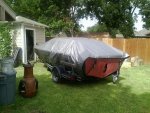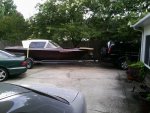Re: 68 AristoCraft 8-teen off and running
Lt. Dan, just a little insight on what little I know:
In aviation repairs, the composite is only as strong as the material used + the epoxy that is used with it and the curing temperature + the "clamping" system used.
The combination of the two (plus the cure temperature) yields either Tensile or Compressive strength or a combination of both. This can be augmented with applications of the same material in various warp-weft directions such as Ply1 0?, P2 90?, P3 45?, P4 90?, P5 0? overlapping only 1" at the seems. Sometimes layers of "Tape" are used usually running diagonally across a part. These layers usually do not overlap, but just butt together.
Also we use Ambient cure epoxies that can take up to 72 hours to achieve ultimate strength (many can be accelerated cured using up to 200?F temp by using heat lamps), but there are also epoxies that can be Portable Hotbond (heat pad cured), oven cured, or autoclave cured, all resulting in different Tensile Strength using the same adhesive system.
Kevlar, considered a Fiberglass, is stronger than regular glass, and Carbon Fabric is also stronger while being considerably lighter at the same time and there is also Boron which is used as well. There again, depending on which material you use, the thickness, and the weave, vast differences can be achieved. There are several different styles available, Plain Weave, Basket Weave, Leno Weave, Crows-foot, Satin, and Harness, all used for different reasons. Carbon fabric almost always uses a glass, sanding layer as a top layer. Kevlar fuzzes bad when cut so it is usually covered with glass too.
Most of what we use for small repairs (up to 3' by 6') is fabric and cold-bond epoxy, but when we are faced with larger repairs with multiple layers such as an Engine Cowl, we use Pre-Preg products (fabric per-impregnated with adhesives). There again the combination of material and adhesive is vast and the end strength is also vast. Just the difference between laying a pre-preg or hand reticulating a pre-preg can be several hundred psi in strength.
Vacuum is different than Air Pressure. Air lines can be increased in size and bends and Tees can be calculated for loss, however, distance is Vacuum's enemy. Keep vacuum lines short, under 10'-15' runs.
Vacuum, even using the best vacuum system will not develop absolute vacuum (which is 29.9 in.-Hg or roughly 14psi at sea level; those living in Denver will never see values this high). We have massive pumps and use venturii in addition and rarely create over 26 - 28 in. vacuum at a little over 1200ft elevation. if you can achieve 22 in. -Hg, that translates into around 10.8psi. which on a one square foot area (12" x 12" = 144 sq. in.) is over 1500lbs of pressure (144 sq. in. x 10.8psi = 1,555.2lbs) which is considerable pressure for clamping. Autoclaves use vacuum to hold the part in place and after the door is closed, the cavity of the clave is filled with either compressed air or dry Nitrogen for the "Holding Pressure". At that time the vacuum is usually removed for the cure. Holding Pressure can be as high as 45 to 90psi for composite assemblies.
When heat cured adhesives are used, various adhesives systems use different cure temperatures sometimes involving various elevated temperatures, the the later, higher temperatures known as "post-cure" to harden already cured adhesives and utilize sometimes hours to post-cure.
I spend hours daily comparing materials that were used at the time of manufacture with those that are available today, some being as weak as <1ksi to those when cured as high as 65ksi.
Our materials run 900$ to 2800$ per roll for 52" wide fabrics. Some are available "Cut" but usually there is a minimum buy and the price/ sq. ft. goes up on those purchases.
I can't remember what drive you are employing, but most MerCruisers call out a transom thickness of 2-2 1/4" (51-57mm) with the transom surfaces parallel to withing 0.125" (1/8" or 3.2mm) and the inner surface just as flat for the area covered by the transom plate, flat to 0.125" (1/8" or 3.2mm) while the outer surface flat within 0.0625" (1/16" or 1.6mm) for the Gimbal Housing Assembly regardless of any curve there may be in your transom.
Any built-up, whether balsa or ply, or even OSB (Orientated Strand Board (Waffler Board)) is a laminate. Laminates are employed all the time in all phases and walks of life, i.e. Press-Lam beams used in home construction have just about ended the use of bolted together dimensional S.P.F. (Spruce, Pine, or Fur) beams.
Marine epoxy adhesives systems are basically the same as aerospace/ aviation systems, two-component thixotropic ambient cure adhesives. Marine will try to sell the idea that theirs is impervious to water, while aerospace has to be impervious to moisture intrusion but capable of enduring a little greater temperature span, -100?F to as high as 900+?F, sometimes within just a few minutes of one another. I have sent specimens for 72 hour 100% Salt Spray and Humidity tests on a monthly basis, something I don't think is a requirement in Marine yet.
Unless you are building a spacecraft or something, I would scarf some parallel saw cuts in your plywood or Balsa (usually 2/3rds of the way through), making it bendable, and clamp up multiple layers and be done with it. If you have a compound radii, you will have to cut your plywood or Balsa in strips as well to make the second bend. Make sure to use enough Resin/ PB to fill the scarf cuts too.
Use something like Woodonglass's Jorgenson style Transom clamps and go to town with it.
Also, remember to not completely starve the joint when clamping. You want even clamping pressure fully across the assembly and enough resin where there is even adhesion and some squeeze out to insure there is enough resin. This is a feel and you may have to experiment some. I would recommend using a construction type notched trowel using it to apply adhesive in one direction on one piece and a direction which is perpendicular to it on the adherend piece.
Also, if you go with some sort of composite, unless you put all the pieces together on the adhesive system, you may end up lighter, but you may end up with junk not capable of supporting the HIN tag when your done.
Do some serious exploration of materials, tensile and compressive strength of the combined products, and then do some serious number crunching, then ask someone who has worked with that composite/ resin system and have them check your work. I do it daily either with Fleet Support, Stress, or FAA DERs and not embarrassed by it at all. A second set of eyes will catch a simple mistake you have overlooked many times.
Finally, see if all of it is worth it just to save a couple pounds in weight while maybe gaining a few pounds of strength. I would go with simple tried-n-true which is way out of character for me, but why reinvent the wheel.
I "Over Engineer" everything I do :nerd:, but I tend to keep my explanations brief! :facepalm:



























